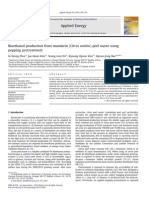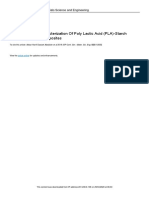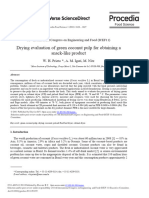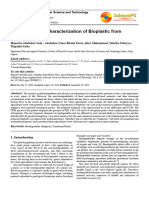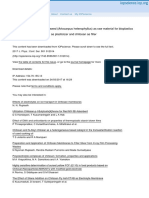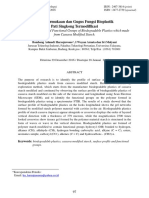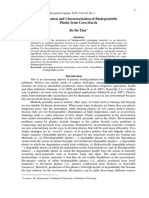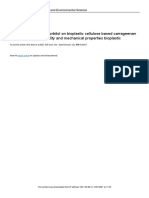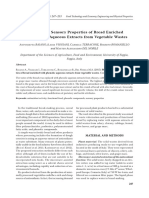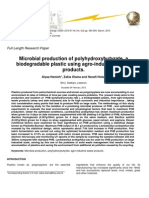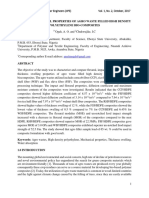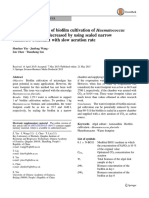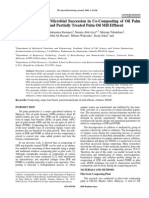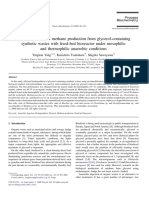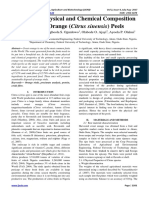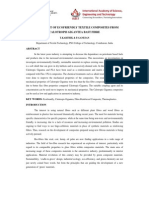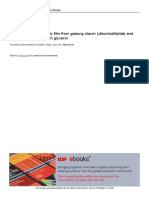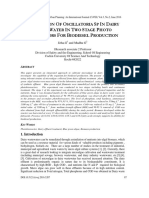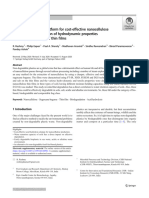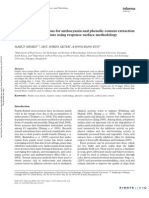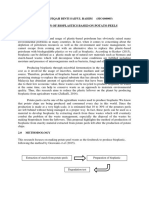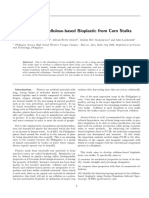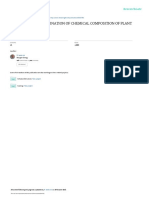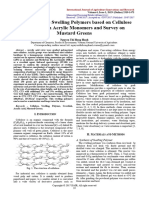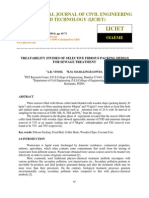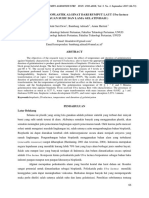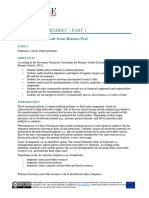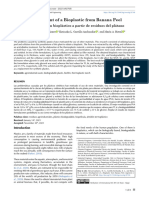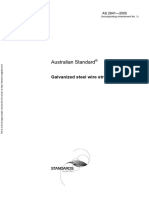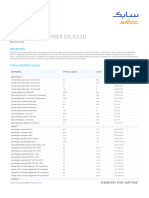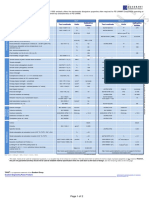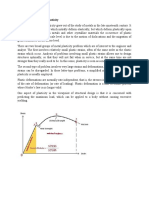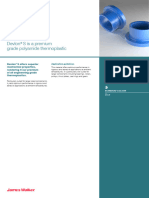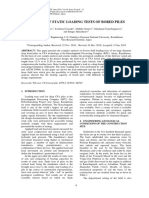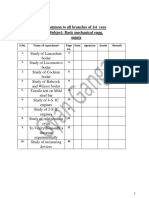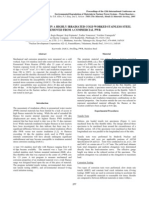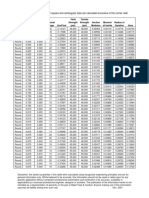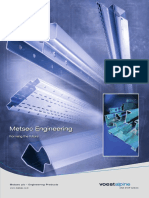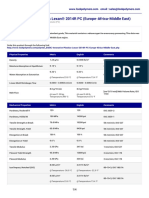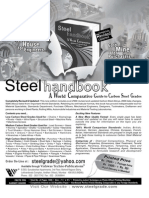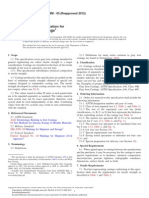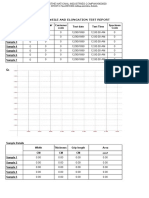Download
Download
Uploaded by
jhoanna grace nideaCopyright:
Available Formats
Download
Download
Uploaded by
jhoanna grace nideaCopyright
Available Formats
Share this document
Did you find this document useful?
Is this content inappropriate?
Copyright:
Available Formats
Download
Download
Uploaded by
jhoanna grace nideaCopyright:
Available Formats
Vol.
65: e22210789, 2022
https://doi.org/10.1590/1678-4324-2022210789
ISSN 1678-4324 Online Edition
Article - Environmental Sciences
Physical and Mechanical Properties of Biodegradable
Pot Derived from Oil Palm Empty Fruit Bunch and
Sodium Alginate
Jaka Darma Jaya1,2
https://orcid.org/0000-0002-4551-5417
Muthia Elma1,3,4
https://orcid.org/0000-0002-3984-4855
Sunardi Sunardi1, 4
https://orcid.org/0000-0002-8537-4778
Agung Nugroho1,4,5*
https://orcid.org/0000-0002-7236-9654
1
Lambung Mangkurat University, Doctoral Program of Agricultural Science, Banjarbaru, South Kalimantan, Indonesia;
2
Tanah Laut State Polytechnics, Department of Agroindustry, Pelaihari, South Kalimantan, Indonesia; 3 Lambung
Mangkurat University, Faculty of Engineering, Department of Chemical Engineering, Banjarbaru, South Kalimantan,
Indonesia, 4Lambung Mangkurat University, Wetland-Based Materials Research Center, Banjarmasin, South
Kalimantan, Indonesia; 5Lambung Mangkurat University, Faculty of Agriculture, Department of Agro-industrial
Technology, Banjarbaru, South Kalimantan, Indonesia.
Editor-in-Chief: Alexandre Rasi Aoki
Associate Editor: Alexandre Rasi Aoki
Received: 07-Dec-2021; Accepted: 09-May-2022.
*Correspondence: anugroho@ulm.ac.id; Tel.: +62-858-6736-3340 (A.N.).
HIGHLIGHTS
• Oil palm empty fruit bunch is sufficient to be used as reinforcement on the biopot production.
• Application of sodium alginate deliver a positive effect on the biopot’s mechanical properties.
• Properties of the developed biopot indicate the possibility to substitute the plastic pot use.
Abstract: Efforts to overcome the problem of agroplastic waste (in the form of pots, polybags, and other
planting containers) continue to be studied. This research investigated the use of oil palm empty fruit bunch
(OPEFB) and sodium alginate in the production process of biodegradable pots. This study also investigated
the comprehensive features of biodegradable pots which included physical, mechanical, structural
(chemical), and morphological properties. Physical and mechanical characterization showed that the
moisture content, specific gravity, water absorption, ultimate tensile strength (UTS), and elongation at break
of the examined biodegradable pots increased with increasing sodium alginate content. Biopot-3 with 15%
sodium alginate exhibited the highest UTS at 1.29 MPa and elongation at break at 6.77%. FTIR spectra in
the 400-4000 cm-1 region showed that all examined biodegradable pots exhibited identical spectra which
most of the peaks showed the characteristics of cellulose, hemicellulose, and alginate. While, XRD patterns
showed that the biodegradable pot material has an amorphous structure with 2θ angles being 21.69º, 22.01º,
Brazilian Archives of Biology and Technology. Vol.65: e22210789, 2022 www.scielo.br/babt
Jaya, J.D.; et al. 2
and 22.03º, respectively. Surface morphology analysis by SEM revealed that Biopot-1 containing 5% sodium
alginate (the lowest sodium alginate content) exhibited many porous cavities, indicating that the matrix could
not completely fill the space between the fibers. It contrasts with Biopot-2 and Biopot-3 (10% and 15% sodium
alginate, respectively), which have a morphology with a denser surface. In general, the produced
biodegradable pots exhibited adequate functional properties as ecologically friendly planting containers, but
further research is required to investigate their field applicability.
Keywords: agroplastic; biocomposite; biopot; cellulose; thermopressing.
GRAPHICAL ABSTRACT
INTRODUCTION
Plastic waste, including agro-plastics such as pots and polybags, has been the most severe
environmental problem due to their resistant to decomposition by natural processes [1,2]. Organic materials
based-planting containers or biodegradable pots are alternatives to answer the issues. Moreover,
biodegradable pots (biopots) are not harmful to the plant roots because they can be transferred directly from
the nursery to the plantation without disassembly [3–10]. Various high fiber biomass, such as coconut frond
and fiber, wood fiber, paddy husk and straw, mushroom substrates, banana peel, and also cow manure have
been studied as reinforcing substances in the production of biopots [3,4,11–15]. Oil palm empty fruit bunch
(OPEFB) is one of the interesting and potential material for biopot reinforcement due to its high content of
fibers (72%).
As the world's largest palm oil producer, Indonesia produce more than 50 million tons of crude palm oil
(CPO) in 2020 and simultaneously generates the same amount of OPEFB as the waste of the CPO
production process [16,17]. Comparing to other biomass, OPEFB seems to have a good potential to be
utilized as reinforcing material in the production of planting container due to its abundance, low price, and
high fiber content. OPEFB has been reported to contains good nutrient composition that potential to be used
for improvement of soil structure and reduction of the uses of chemical fertilizers [17–20]. Investigation on
the physical and mechanical performance of biopots reinforced with OPEFB has not been performed.
Physical and mechanical properties of biopots are determined by the reinforcement materials and also the
matrix. Many natural and synthetic polymers have been used as matrix in the biopot production such as
cassava starch, formaldehyde copolymer, polyethylene glycol, polyhydroxy butyrate, paraffin wax, and
sodium alginate [4,5,7,9,21–23]. Sodium alginate has been reported to have appropriate properties as a
polymeric matrix because of its abundance, effectiveness in the gel formation, good mechanical performance,
and affordable price [4,24]. This study was aimed to investigate the effects of the application of OPEFB as
the reinforcement and various concentration of sodium alginate matrix on the physical, mechanical, structural,
and morphological characteristics of the biopots.
Brazilian Archives of Biology and Technology. Vol.65: e22210789, 2022 www.scielo.br/babt
Jaya, J.D.; et al. 3
MATERIAL AND METHODS
Material Preparation
The material used in this research was Oil Palm Empty Fruit Bunches (OPEFB). OPEFB waste was
collected from the Palm Oil Processing Plant in Pelaihari, Indonesia. The material was crushed and sun-dried
for 2-3 days to produce OPEFB with a moisture content below 10%. The material was then homogenized in
size with a sieve (25 mesh). To get early information regarding the OPEFB material, lipid content, moisture
content, and lignocellulose content were analyzed. In the production of biopots, sodium alginate was
employed as a matrix that also acts as an adhesive. Prior to use, sodium alginate was combined with distilled
water and agitated until a homogenous gel formed.
Production of Biodegradable Pot
Sodium alginate was dissolved in 50 mL of distilled water and stirred for 5 min to form a homogeneous
gel. The OPEFB material (10 g) and glycerol (0.5 g) was then added to the adhesive solution and
homogenized with a stirrer to create a ready-to-mold paste. Sodium alginate was employed at concentrations
of 5% (Biopot-1), 10% (Biopot-2), and 20% (Biopot-3) of the weight of the OPEFB. The formulation of the
biopot was put into an iron mold designed to resemble the desired shape of the pot with an upper diameter
of 9 cm, a bottom diameter of 6 cm, and a height of 7 cm. The thermopressing process was employed to
mold at a temperature of 150ºC for 5 min. Biopot was removed from the mold and stored in a dry container.
Physical Characterization
Moisture Content
The empty cup was dried for 15 min at 105ºC, cooled in a desiccator, and weighed (W2). The weight of
the biopot specimen was measured (W) and then put into the cup. Following that, the specimen was placed
in a 105ºC oven for 4 hours or until the weight remained steady. The cup containing the sample was cooled
in a desiccator and then weighed (W1). The moisture was calculated using the following formula.
𝑾−(𝑾𝟏 −𝑾𝟐)
𝑴𝒐𝒊𝒔𝒕𝒖𝒓𝒆 = 𝑾
× 𝟏𝟎𝟎% (1)
Water Absorption
Biopot dry specimens were weighed and marked as W0. The specimens were then immersed in distilled
water for 15 and 30 min at room temperature and weighed. The excess water on the specimen's surface was
gently wiped away with a damp cloth/tissue before weighing. Wt represented the weight after immersion.
Each of these treatments was repeated three times, and the average results were used to determine the
water adsorption value (Q) using the equation below:
𝑾𝑯 𝟐 𝑶
𝑸= 𝑾𝟎
× 𝟏𝟎𝟎% (2)
Note; 𝑊𝐻2 𝑂 = 𝑊𝑡 − 𝑊0
𝑊𝐻2 𝑂 = 𝑊𝑒𝑖𝑔ℎ𝑡 𝑜𝑓 𝑤𝑎𝑡𝑒𝑟 𝑎𝑏𝑠𝑜𝑟𝑏𝑒𝑑
Density
The biopot specimens were prepared to a size of 20 mm × 30 mm. Their thickness was measured with
a micrometer screw. Volume was calculated by multiplying the area and thickness of the specimen.
Furthermore, the specimen was dried in an oven, weighed (W), and measured its density (d) using the
following equation:
𝑾
𝒅 =𝑽 (3)
Colorimetric Analysis
A colorimeter (CR-400 Konica Minolta, Japan) was used to determine the color of the biopot. The CIELab
color system (L* (a lightness factor); a* (redness factor); and b* (yellowness factor) was used to determine
the color difference between biopot samples of various compositions.
Brazilian Archives of Biology and Technology. Vol.65: e22210789, 2022 www.scielo.br/babt
Jaya, J.D.; et al. 4
Contact Angle Analysis
Contact angle analysis using plug-in drop analysis was used to determine the hydrophobicity of biopot
specimens. Furthermore, the contact angle and hydrophobicity were determined. The instrument used in this
test is a contact angle goniometer (Dataphysic Instrument, TBU 100).
Mechanical Characterization
Mechanical characteristics of biopot were investigated through the tensile test. Tensile strength,
elongation at break, and other tensile properties are critical indicators of a biopot's performance and quality
[25]. The test was carried out with three replications using prepared specimens of the biopot (25 mm ×30
mm) with a 2 mm/min extension rate. The following formulas were used to determine the tensile
characteristics of the biopots:
𝑭
𝑻𝒆𝒏𝒔𝒊𝒍𝒆 𝒔𝒕𝒓𝒆𝒏𝒈𝒕𝒉 = 𝒔𝒕𝒓𝒆𝒔𝒔 = 𝑨 (4)
∆𝑳
𝑬𝒍𝒐𝒏𝒈𝒂𝒕𝒊𝒐𝒏 (%) = 𝒔𝒕𝒓𝒂𝒊𝒏 = 𝑳 × 𝟏𝟎𝟎 % (5)
𝟎
Note; F = Force; A = cross-sectional area; ∆𝐿 = length extension; 𝐿0 = initial length
Structural and Morphological Characterization
Fourier Transform Infra-Red (FTIR) Analysis
The functional groups of the chemical components in the biopot composite mixture were qualitatively
analyzed using FTIR. The samples were dried, pulverized, and pelletized with KBr before being examined by
FTIR using the Shimadzu IR Prestige 21 instrument. Spectra were obtained in the wavelength range of 4000-
600 cm-1 with 40 scans at a resolution of 4 cm-1.
X-ray Diffraction (XRD) Analysis
X-ray Diffraction (XRD) analysis aimed to identify the crystalline phase in the biopot sample. The test
was carried out with the X-ray Diffractometer PANAanalytical-E'xpert Pro equipped with High Score Plus
Software. The instrument was run with a Cu radiation source at a range of 2θ from 10º to 90º.
Scanning Electron Microscopy (SEM) Analysis
SEM analysis using the FEI Inspect-S50 SEM instrument was used to determine the surface of the biopot
sample microscopically, which includes the material's surface topography and appearance. Micrographs
obtained with magnifications of 2500×.
RESULTS AND DISCUSSION
OPEFB was the primary material used in the production of biopots. Drying, refining, and size sorting
were carried out at this initial stage to obtain OPEFB fibers with homogeneous sizes. Additionally, OPEFB
fiber was tested for moisture, lipid, and lignocellulose content in order to acquire uniform and suitable raw
materials. Table 1 showed the initial characteristics of OPEFB material which were then used for further
study.
In this study, biopots were made by combining OPEFB natural fiber with sodium alginate. In this mixture,
the fiber functions as a reinforcement, while the sodium alginate acts as a matrix and adhesive. A total of 10
g of OPEFB was mixed with sodium alginate with variations of 5%, 10%, and 15% and then formed using the
thermopressing method at a temperature of 150ºC for 5 min. The thermopressing process was chosen due
to its simple technology, ease of use, and timeliness of application [26]. Figure 1 shows the biopots produced
using this method.
Brazilian Archives of Biology and Technology. Vol.65: e22210789, 2022 www.scielo.br/babt
Jaya, J.D.; et al. 5
Table 1. Physical and chemical characteristics of OPEFB fiber used in biopot production.
Parameters Value
Moisture (%) 8.83±0.35
Lipid content (%) 4.11±0.80
Fiber length (mm) 10-15
Fiber size (µm) ≤ 710
Hemicellulose content (%) 32.00±1.88
Cellulose content (%) 41.35±1.64
Lignin content (%) 16.07±2.04
Figure 1. Physical appearance of the produced biopots - Biopot-1 (5% sodium alginate); Biopot-2 (10% sodium
alginate); Biopot-3 (15% sodium alginate).
Furthermore, biopots were characterized to determine their suitability for use as an alternative planting
container. Comprehensive characterization of biopots was then performed, including physical, mechanical,
structural (chemical), and morphological characterization.
Physical Characteristics
Moisture content, water absorption, density, colorimetric and contact angle were the physical properties
examined in this study. The moisture analysis revealed that the more sodium alginate in the biopot, the higher
the moisture. Biopot-3 containing 15% sodium alginate showed the highest moisture of 8.18%. Meanwhile,
Biopot-1 containing 5% sodium alginate showed the lowest moisture of 6.81% (Table 2). It is critical to
understand the moisture of biopots in order to predict their susceptibility to damage caused by organisms
such as bacteria and fungi, particularly during storage [12,27,28]. On the other hand, the moisture of biopots
could be allowed because it will contact with water while watering or when transferred to the soil in agricultural
application.
Table 2. Physical properties of the examined biopots
Parameters
Treatment Water Absorption (%)
Density
Moisture (%) 15 min water
(g/cm3) 30 min water immersion
immersion
Biopot-1 0.177±0.039 6.81±0.35 146.88±22.32 300.87±49.57
Biopot-2 0.230±0.021 7.29±0.06 157.06±11.37 305.15±16.78
Biopot-3 0.264±0.024 8.18±0.19 236.74±22.58 401.80±38.06
The water absorption test was used to ascertain the specimen's interaction with the water. The
application of biopots for planting containers will undoubtedly contact with water molecules in the
Brazilian Archives of Biology and Technology. Vol.65: e22210789, 2022 www.scielo.br/babt
Jaya, J.D.; et al. 6
environment. The material was immersed in distilled water for 15 and 30 min to determine its water absorption
capacity. Biopot’s specimens with higher sodium alginate concentrations had higher water absorption than
specimens with lower sodium alginate concentrations. Biopot-3 with 15% sodium alginate content showed
highest water absorption of 236.74% at 15 min of immersion and 401.80% at 30 min of immersion,
respectively. While, Biopot-1 containing 5% sodium alginate showed the lowest water absorption of 146.88%
at 15 min of immersion and 300.87% at 30 min of immersion (Table 2). This finding is almost the same as
the water absorption capacity of biopot made of tomato, hemp fiber, and cow manure which showed values
of 190 % and 476% [4,15]. The longer it is immersed, the higher the moisture in the biopot. The water
absorption capacity of the biopot is determined by the constituent materials and is closely related to the
porosity and density of the biopot [15]. On the other hand, the ability to absorb water could also be an
advantages to biopot, since it can be employed as a water reservoir when used in agricultural application [6].
Another physical property observed in this study was density. Density indicates the compactness of the
biopot’s ingredients. Density values are strongly dependant on fiber density and the degree of compression
used during processing. In general, fiber composites have a relatively low density [3,4,9]. Biopots made of
OPEFB with sodium alginate had a density of 0.177–0.264 g/cm3 (Table 2). The higher the sodium alginate
level, the higher the density, as alginate works as both a matrix and an adhesive in the mixture [4]. Due to
the high concentration of sodium alginate, the component materials' cohesiveness is increased, resulting in
an increase in density. When compared with similar products from previous studies made from waste of
tomato-hemp fibers [4] and straw fibres [9] as raw materials, which showed densities of 0.43 g/cm3 and 0.81
g/cm3, respectively, the biopots produced from this research were lighter, so that expected to be simpler in
transportation and storage.
Colorimetric analysis was carried out to see the difference in the color and appearance of each biopots,
as done in several studies [29,30]. Color values were expressed in lightness (L), redness (a), and yellowness
(b) measured using a colorimeter. The lightness (L) of the combination tends to increase as the sodium
alginate concentration in the mixture increases. Meanwhile, Yellowness (b) tends to decrease with the
increasing concentration of sodium alginate. Similarly, as the concentration of alginate in the mixture
increases, the redness (a) decreases slightly. The color of biopots is determined by two critical factors: the
composition and the heating technique during thermopressing.
Figure 2. Colorimetric value of the tested biopots.
Another physical property analyzed in this study was the contact angle. In principle, the contact angle
indicates the surface's wettability. Hydrophilic liquids have a contact angle of less than 90° with the solid
surface, whereas hydrophobic (non-wetting) liquids have a contact angle of 90-180°. In this study, the contact
angle of the examined biopot ranged from 81.67-103.72o. Biopot-3, which contained 15% sodium alginate,
was hydrophilic based on the contact angle value, whereas Biopot-1 and Biopot-2 were classified as
hydrophobic (non-wetting). The contact angle is further influenced by the material's porosity, roughness, and
heterogeneity of the surface topography.
Brazilian Archives of Biology and Technology. Vol.65: e22210789, 2022 www.scielo.br/babt
Jaya, J.D.; et al. 7
Figure 3. Contact angle of the examined biopots.
Figure 4. Contact angle of Biopot-3 with hydrophobic angle of <90o (a) and Biopot-2 with hydrophilic angle of >90o (b).
Mechanical characteristics
Mechanical characteristics of biopot were investigated through tensile test. Tensile properties are critical
characteristics of biopots. The tensile properties studied were ultimate tensile strength (UTS), elongation at
break, and stress-strain curve. UTS is the maximum stress that a specimen can withstand when stretched.
Biopot-1, Biopot-2 and Biopot-3 had a UTS value of between 0.617 and 1.290 MPa. Increasing the sodium
alginate content resulted in a rise in the biopot's UTS value. This value is almost similar to that of biopots
originating from wood fiber of 0.1 M.Pa [15]; tomatoes and hemp fiber of 0.46 MPa [4]. In several studies,
adding plasticizers such as polyester and polyethylene glycol to the biopots resulted in higher UTS values as
shown in previous studies [22,25].
The elongation value ranged between 4.79% and 6.77% during cracking, with the maximum value
occurring at Biopot-3. The relationship between tensile strength and elongation is illustrated on a stress-strain
graph that showed a similar pattern for all biopots. When the curve reaches the peak point (UTS), there is a
decrease in stress due to cracks in the test specimen. In general, all test specimens exhibited the same
pattern, with a broad peak indicating that the test specimen was elastic (ductile fracture), as opposed to non-
elastic specimens, which had sharper peaks (Figure 6) [15].
The performances of the biopots were relatively better compared to other related or similar products of
the previous research, such as biopot, biocontainer, and green polybag [3,4,9,15,22]. Table 3 shows the
comparison of the physical and mechanical properties of the tested biopots with other related products. As
shown, the tested biopots were better in three parameters of biopot quality (water adsorption, density, and
tensile strength).
The biopot is also economically reliable because of its low production cost, either the material price or
the processing cost. OPEFB is the waste of CPO production process and generally worthless. Sodium
alginate is also can be obtained at the affordable price and it is only used in a small quantity of around 1 g
for each single biopot. In addition, in term of time efficiency, thermopressing method is more preferable than
the cold process which takes up to 3 days [4,31,32]. This is essential in efforts to save the storage space and
working hour.
Brazilian Archives of Biology and Technology. Vol.65: e22210789, 2022 www.scielo.br/babt
Jaya, J.D.; et al. 8
Figure 5. Ultimate tensile strength (UTS) and elongation at break of the examined biopots.
Figure 6. Curve of stress-strain of the examined biopots.
Table 3. Comparison of the physical and mechanical properties of the tested biopots with other related products
Parameter Raw materials Value Ref.
OPEFB 146.88 Research data
Tomato waste
Water adsorption (%) 190.00 [4]
Hemp fibers
Cow manure 476.00 [15]
OPEFB 0.18 Research data
Tomato waste
Density (g/cm3) 0.43 [4]
Hemp fibers
Straw 0.81 [15]
OPEFB 1.30 Research data
Tomato waste
Tensile strength (MPa) 0.46 [4]
Hemp fibers
Wood fibers 0,10 [15]
OPEFB 6.77 Research data
Protein Hydrolysate-PEG-
Elongation at break (%) 1.00 [22]
Wood Flour
Biodegradable Polyester
48.70 [25]
Plant fibers
Brazilian Archives of Biology and Technology. Vol.65: e22210789, 2022 www.scielo.br/babt
Jaya, J.D.; et al. 9
Structural and Morphological Characteristics
FTIR spectra
The FTIR test was performed to understand about the chemical linkages found in the biopot sample,
which the different peaks indicate the typical chemical bonds. A biopot is a composite consisting of OPEFB
fiber as reinforcement and sodium alginate as a matrix. The results showed that the spectra of Biopot-1,
Biopot-2, and Biopot -3 were similar. Most of the peaks showed the characteristics of cellulose, hemicellulose,
and alginate. Only the transmittance intensity was slightly different at certain peaks, indicated the difference
in quantity of each functional groups. The infrared spectrum revealed a strong broad absorption band at 3321
and 3344 cm-1. It indicated the presence of stretching OH groups in cellulose and alginate compounds, which
are associated with a high number of hydrogen bonds. Absorption bands at wavelengths 2945, 2943, and
2941 cm-1 were asymmetric stretching of CH, CH2, and CH3 (methylene and methyl group) in cellulose. The
absorption bands at 1168 and 1166 cm-1 indicated the presence of C-O-C stretching vibration in cellulose
and alginate. Similarly, the bands at 820 and 817 cm-1 showed a C-H deformation of the β-(1,4) glycosidic
linkage in cellulose, as well as a C-H deformation of the linkage in alginate [30,33].
Figure 7. FTIR Spectra of the examined biopots.
X-ray Diffraction (XRD) Analysis
X-ray diffraction (XRD) analysis was aimed to identify the crystalline phase in the biopot from OPEFB
with the different content of sodium alginate. Diffraction patterns of Biopot-1, Biopot-2 and Biopot-3 can be
seen in Figure 8, showing that the biopot material has an amorphous structure with 2θ angles being 21.69º,
22.01º and 22.03º, respectively. The peak intensity of the tested biopot showed a slight increase with
increasing sodium alginate [(C6H7NaO6)n] in samples. Lignocellulosic fiber and sodium alginate are the main
constituents of the biopots. Those materials are organic that naturally are irregular (amorphous) [34–38]. This
condition will affect the results of the XRD analysis of the biopots which are also amorphous as indicated by
the absence of crystalline peaks.
Brazilian Archives of Biology and Technology. Vol.65: e22210789, 2022 www.scielo.br/babt
Jaya, J.D.; et al. 10
Figure 8. X-ray diffractogram of the examined biopots.
Scanning Electron Microscope (SEM)
The morphology of the biopot, which was composed of fiber and sodium alginate, was examined using
SEM analysis. On the surface of the Biopot-1 containing 5% sodium alginate (the smallest sodium alginate
content), several porous cavities formed, indicating that the matrix could not completely fill the space between
the fibers. It contrasts with Biopot-2 and Biopot-3, which contain higher sodium alginate (10% and 15%
sodium alginate), showing denser morphology. A sodium alginate matrix strongly influences the level of
porosity of the biopot. Additionally, biopots containing a higher concentration of sodium alginate (Biopot-3)
had a smoother surface than biopots containing a lower concentration of sodium alginate (Biopot-1). The
matrix acts as a filler, transferring tension to the fiber, forming a coherent link between the fiber and matrix
surface, and protecting the fiber.
Figure 9. SEM micrograph of the examined biopots with 2500x magnification.
Brazilian Archives of Biology and Technology. Vol.65: e22210789, 2022 www.scielo.br/babt
Jaya, J.D.; et al. 11
CONCLUSION
Biopots made of oil palm empty fruit bunches (OPEFB) and sodium alginate have the potential to be an
environmentally friendly alternative to conventional planting containers. The quality of biopots is determined
by product characteristics such as the material's physical, mechanical, structural (chemical), and
morphological properties. The final characteristics of the biopot are primarily determined by the type of filler
and matrix used, and this study used OPEFB and sodium alginate. The development and application of
biodegradable containers are intended to be a novel method to achieve the sustainable agricultural objective
of balancing productivity and environmental concerns.
Funding: This research was funded by Ministry of Education, Culture, Research and Technology of the Republic of
Indonesia through a Doctoral Dissertation Research Grant (031/E4.1/AK.04.PT/2021).
Acknowledgments: The authors would like to acknowledge the Ministry of Education, Culture, Research and
Technology of the Republic of Indonesia and Doctoral Program of Agricultural Science, Lambung Mangkurat University
for supporting the research.
Conflicts of Interest: The authors declare no conflict of interest.
REFERENCES
1. Jambeck JR, Ji Q, Zhang Y-G, Liu D, Grossnickle DM, Luo Z-X. Plastic waste inputs from land into the ocean.
Science (80- ). 2015;347(6223):768–71.
2. Akhir J, Allaily, Syamsuwida D, Budi SW. Water absorption and quality of environmentally friendly seedling
containers made from waste paper and organic materials. Rona Tek Pertan. 2017;10(2):1–11.
3. Postemsky PD, Marinangeli PA, Curvetto NR. Recycling of residual substrate from Ganoderma lucidum
mushroom cultivation as biodegradable containers for horticultural seedlings. Sci Hortic (Amsterdam) [Internet].
2016;201:329–37. Available from: http://dx.doi.org/10.1016/j.scienta.2016.02.021
4. Schettini E, Santagata G, Malinconico M, Immirzi B, Scarascia Mugnozza G, Vox G. Recycled wastes of tomato
and hemp fibres for biodegradable pots: Physico-chemical characterization and field performance. Resour
Conserv Recycl [Internet]. 2013;70:9–19. Available from: http://dx.doi.org/10.1016/j.resconrec.2012.11.002
5. Balestri E, Vallerini F, Seggiani M, Cinelli P, Menicagli V, Vannini C, et al. Use of bio-containers from seagrass
wrack with nursery planting to improve the eco-sustainability of coastal habitat restoration. J Environ Manage
[Internet]. 2019;251(July):109604. Available from: https://doi.org/10.1016/j.jenvman.2019.109604
6. Calcagnile P, Sibillano T, Giannini C, Sannino A, Demitri C. Biodegradable poly(lactic acid)/cellulose-based
superabsorbent hydrogel composite material as water and fertilizer reservoir in agricultural applications. J Appl
Polym Sci. 2019;136(21):1–9.
7. Rafee SNAM, Lee YL, Jamalludin MR, Razak NA, Makhtar NL, Ismail RI. Effect of Different Ratios of Biomaterials
to Banana Peels on the Weight Loss of Biodegradable Pots. Acta Technol Agric. 2019;22(1):1–4.
8. Saba N, Jawaid M, Sultan MTH, Alothman OY. Green Biocomposites for Structural Applications Green
composites. Springer International Publishing; 2017. 1–27 p.
9. Sun E, Liao G, Zhang Q, Qu P, Wu G, Huang H. Biodegradable copolymer-based composites made from straw
fiber for biocomposite flowerpots application. Compos Part B Eng [Internet]. 2019;165(November 2018):193–8.
Available from: https://doi.org/10.1016/j.compositesb.2018.11.121
10. Seggiani M, Cinelli P, Balestri E, Mallegni N, Stefanelli E, Rossi A, et al. Novel sustainable composites based on
poly(hydroxybutyrate-co-hydroxyvalerate) and seagrass beach-CAST fibers: Performance and degradability in
marine environments. Materials (Basel). 2018;11(5).
11. Asmara S, Rahmawati W, Suharyatun S, Kurnia B, Listiana I, Widyastuti RAD. Producing organic pot from
cassava stem waste for water spinach (Ipomea reptans Poir) as waste management strategy. Conf Ser Earth
Environ Sci. 2021;739:12039.
12. Beeks SA, Evans MR. Physical properties of biocontainers used to grow long-term greenhouse crops in an ebb-
and-flood irrigation system. HortScience. 2013;48(6):732–7.
13. Sahari J, Sapuan SM. Natural fibre reinforced biodegradable polymer composites. Rev Adv Mater Sci.
2012;30(2):166–74.
14. Zhang Y, Zhu Q-J, Gao S, Liu S, Li L-H, Chen H-T. Optimization of Technological Parameters of Straw Fiber-
Based Plant Fiber Seedling Pot Raw Materials. Appl Sci 2021, Vol 11, Page 7152 [Internet]. 2021 Aug 3 [cited
2021 Nov 1];11(15):7152. Available from: https://www.mdpi.com/2076-3417/11/15/7152/htm
15. Zhang X, Wang C, Chen Y. Properties of selected biodegradable seedling plug-trays. Sci Hortic (Amsterdam)
[Internet]. 2019;249:177–84. Available from: https://doi.org/10.1016/j.scienta.2019.01.055
16. Haryanti A, Norsamsi, Sholiha PSF, Putri NP. Study of Palm Oil Solid Waste Utilization (in Indonesian). J
Konversi. 2014;3(2):20–2.
17. Erwinsyah, Afriani A, Kardiansyah T. Potential and Opportunities of Oil Palm Empty Fruit Bunches as Raw
Material for Pulp and Paper: A Case Study in Indonesia (in Indonesian). J Selulosa. 2015;5(02):79–88.
18. Trisakti B, Mhardela P, Husaini T, Irvan, Daimon H. Effect of pieces size of Empty Fruit Bunches (EFB) on
composting of EFB mixed with activated liquid organic fertilizer. IOP Conf Ser Mater Sci Eng. 2018;309(1).
Brazilian Archives of Biology and Technology. Vol.65: e22210789, 2022 www.scielo.br/babt
Jaya, J.D.; et al. 12
19. Zahrim AY, Asis T, Hashim MA, Al-Mizi TMTM., Ravindra P. A Review on the Empty Fruit Bunch Composting: Life
Cycle Analysis and the Effect of Amendment. Adv Bioprocess Technol. 2015;1–15.
20. Jaya JD, Nuryati N, Ramadhani R. Optimasi Produksi Pupuk Kompos Tandan Kosong Kelapa Sawit (TKKS) dan
Aplikasinya pada Tanaman. J Teknol Agro-Industri [Internet]. 2015 Mar 22 [cited 2021 Feb 11];1(1):01. Available
from: http://jtai.politala.ac.id/index.php/JTAI/article/view/24
21. Seggiani M, Cinelli P, Balestri E, Mallegni N, Stefanelli E, Rossi A, et al. Novel sustainable composites based on
poly(hydroxybutyrate-co-hydroxyvalerate) and seagrass beach-CAST fibers: Performance and degradability in
marine environments. Materials (Basel). 2018;11(5):1–16.
22. Sartore L, Schettini E, Bignotti F, Pandini S, Vox G. Biodegradable Plant Nursery Containers from Leather
Industry Wastes. Polym Compos. 2016;39(8):2743–50.
23. Evans MR, Hensley DL, Bailey LH, Star R. Plant Growth in Plastic , Peat , and Processed Poultry Feather Fiber
Growing Containers. 2004;39(5):1012–4.
24. Hecht H, Srebnik S. Structural Characterization of Sodium Alginate and Calcium Alginate. Biomacromolecules
[Internet]. 2016 Jun 13 [cited 2021 Apr 19];17(6):2160–7. Available from:
https://pubs.acs.org/doi/10.1021/acs.biomac.6b00378
25. Castronuovo D, Picuno P, Manera C, Scopa A, Sofo A, Candido V. Biodegradable pots for Poinsettia cultivation:
Agronomic and technical traits. Sci Hortic (Amsterdam). 2015;197:150–6.
26. Abba HA, Nur IZ, Salit SM. Review of Agro Waste Plastic Composites Production. J Miner Mater Charact Eng.
2013;01(05):271–9.
27. Siwek P, Domagala-Swiatkiewicz I, Bucki P, Puchalski M. Biodegradable agroplastics in 21st century horticulture.
Polimery. 2019;64(07/08):480–6.
28. Kasirajan S, Ngouajio M. Polyethylene and biodegradable mulches for agricultural applications: A review. Agron
Sustain Dev. 2012;32(2):501–29.
29. Kaisangsri N, Kerdchoechuen O, Laohakunjit N. Biodegradable foam tray from cassava starch blended with
natural fiber and chitosan. Ind Crops Prod. 2012 May;37(1):542–6.
30. Sunardi S, Istikowati WT, Ishiguri F, Yokota S. FTIR spectroscopy and color change of wood for assessment and
monitoring of softwood degradation by white-rot fungus Porodaedalea pini. AIP Conf Proc. 2018;2026(2018).
31. Jaya JD, Darmawan MI, Ilmannafian AG, Sanjaya L. Quality Green Polybag from Palm Oil Empty Fruit Bunch and
Fiber Waste as Palm Oil Pre Nursery Media. Teknol Agro-Industri. 2019;6(2):127–40.
32. Jaya JD, Ilmannafian AG, Maimunah. Utilization of Palm Oil Waste Fiber in Making Organic Pot. J Sains dan
Teknol Lingkung. 2019;11(1):1–10.
33. Franco TS, Amezcua RMJ, Rodrìguez AV, Enriquez SG, Urquíza MR, Mijares EM, et al. Carboxymethyl and
Nanofibrillated Cellulose as Additives on the Preparation of Chitosan Biocomposites: Their Influence Over Films
Characteristics. J Polym Environ [Internet]. 2020;28(2):676–88. Available from: https://doi.org/10.1007/s10924-
019-01639-0
34. Kane SN, Mishra A, Dutta AK. Characterization and properties of sodium alginate from brown algae used as an
ecofriendly superabsorbent. J Phys Conf Ser. 2016;755(1):1–6.
35. Zakaria S, Hamzah H, Murshidi JA, Deraman M. Chemical modification on lignocellulosic polymeric oil palm
empty fruit bunch for advanced material. Adv Polym Technol. 2001 Dec 1;20(4):289–95.
36. Zhang J, Wang Y, Zhang L, Zhang R, Liu G, Cheng G. Understanding changes in cellulose crystalline structure of
lignocellulosic biomass during ionic liquid pretreatment by XRD. Bioresour Technol. 2014;151:402–5.
37. Lai LW, Ibrahim M, Md Rahim N, Hashim EF, Ya’cob MZ, Idris A, et al. Study on composition, structural and
property changes of oil palm frond biomass under different pretreatments. Cellul Chem Technol. 2016;50(9–
10):951–9.
38. Lacerda VDS, Sotelo JBL, Correa-Guimarães A, Ramos PM, Navarro SH, Bascones MS, et al. Efficient
Microwave-Assisted Acid Hydrolysis of Lignocellulosic Materials Into Total Reducing Sugars in Ionic Liquids.
Cellul Chem Technol. 2016;50(7–8):761–70.
© 2022 by the authors. Submitted for possible open access publication under the terms and
conditions of the Creative Commons Attribution (CC BY NC) license
(https://creativecommons.org/licenses/by-nc/4.0/).
Brazilian Archives of Biology and Technology. Vol.65: e22210789, 2022 www.scielo.br/babt
You might also like
- E-EAN-BBHB-0349-AGR-15 Rev 001Document19 pagesE-EAN-BBHB-0349-AGR-15 Rev 001Jonicus-DextoreNo ratings yet
- Joint Structure and FunctionDocument87 pagesJoint Structure and Functionjay shah90% (21)
- Bioethanol Production From Mandarin (Citrus Unshiu) Peel Waste Using Popping PretreatmentDocument7 pagesBioethanol Production From Mandarin (Citrus Unshiu) Peel Waste Using Popping PretreatmentMicaela Gómez BeauvoirNo ratings yet
- Eco-Friendly Preparation and Characterization of BDocument24 pagesEco-Friendly Preparation and Characterization of BAbdul sayyedNo ratings yet
- Production of Bioplastic From Banana Peels: Supriya Nandlal Kanoujiya and Shivani Kakkar KhannaDocument7 pagesProduction of Bioplastic From Banana Peels: Supriya Nandlal Kanoujiya and Shivani Kakkar KhannaJaymee DelfinadoNo ratings yet
- Fabrication and Characterization of Poly Lactic Acid (PLA) - Starch Based Bioplastic CompositesDocument11 pagesFabrication and Characterization of Poly Lactic Acid (PLA) - Starch Based Bioplastic CompositesAndrea VONo ratings yet
- 1-s2.0-S2211601X11002409-mainDocument10 pages1-s2.0-S2211601X11002409-mainmaithanhdiem666No ratings yet
- 10 11648 J Ajpst 20200602 12Document7 pages10 11648 J Ajpst 20200602 12data.caindog.swuNo ratings yet
- 9632 18647 1 SMDocument7 pages9632 18647 1 SMDewi SrianaNo ratings yet
- Sintese de bioplasticoDocument8 pagesSintese de bioplasticoAlex Rodrigues GomesNo ratings yet
- Profil Permukaan Dan Gugus Fungsi Bioplastik Pati Singkong TermodifikasiDocument7 pagesProfil Permukaan Dan Gugus Fungsi Bioplastik Pati Singkong Termodifikasisekar watiNo ratings yet
- Preparation and Characterization of BiodegradableDocument9 pagesPreparation and Characterization of BiodegradableIzzy Dynielle SolamilloNo ratings yet
- Extraction of Banana PeelsDocument14 pagesExtraction of Banana PeelsFritz CarpenteroNo ratings yet
- Arief 2021 IOP Conf. Ser. Earth Environ. Sci. 679 012013Document7 pagesArief 2021 IOP Conf. Ser. Earth Environ. Sci. 679 012013mochammad diedinNo ratings yet
- Optimization of Bacterial Cellulose Production FromDocument7 pagesOptimization of Bacterial Cellulose Production FromFiqa SuccessNo ratings yet
- Optimization of Bioplastics Tensile StrengthDocument8 pagesOptimization of Bioplastics Tensile StrengthhmossNo ratings yet
- 528-2014 BaianoDocument7 pages528-2014 BaianoMuhammad HashimNo ratings yet
- Microbial Production of Polyhydroxybutyrate, A Biodegradable Plastic Using Agro-Industrial Waste ProductsDocument11 pagesMicrobial Production of Polyhydroxybutyrate, A Biodegradable Plastic Using Agro-Industrial Waste Productsashuna249396No ratings yet
- Welcome To International Journal of Engineering Research and Development (IJERD)Document6 pagesWelcome To International Journal of Engineering Research and Development (IJERD)IJERDNo ratings yet
- Biodegradability of Bioplastic in Natural EnvironmentDocument6 pagesBiodegradability of Bioplastic in Natural EnvironmentIsroi.comNo ratings yet
- Physicomechanical Properties of Agro Waste Filled High Density Polyethylene Bio-CompositesDocument116 pagesPhysicomechanical Properties of Agro Waste Filled High Density Polyethylene Bio-CompositesIheoma Chukwujike NwuzorNo ratings yet
- C01 - Abidah WalfathiyyahDocument10 pagesC01 - Abidah WalfathiyyahaswinNo ratings yet
- Art:10.1007/s10529 015 1864 7Document9 pagesArt:10.1007/s10529 015 1864 7Amal ..No ratings yet
- Characterics and Microbial Succesion in Co-Composting OPEFB and Partially Treated POMEDocument9 pagesCharacterics and Microbial Succesion in Co-Composting OPEFB and Partially Treated POMEedison58No ratings yet
- Utilization of Banana Musa Paradisiaca PDocument11 pagesUtilization of Banana Musa Paradisiaca PAmna liaquatNo ratings yet
- CH4 From Glycerol Yang - 2008Document6 pagesCH4 From Glycerol Yang - 2008spephdNo ratings yet
- Analysis of Physical and Chemical Composition of Sweet Orange (Citrus Sinensis) PeelsDocument6 pagesAnalysis of Physical and Chemical Composition of Sweet Orange (Citrus Sinensis) PeelsIJEAB JournalNo ratings yet
- Adhani 2019Document8 pagesAdhani 2019anggadheta28No ratings yet
- Bio-Hydrogen Generation From Mixed Fruit Peel Waste Using Anaerobic Contact FilterDocument7 pagesBio-Hydrogen Generation From Mixed Fruit Peel Waste Using Anaerobic Contact FilterLiviaBFNo ratings yet
- Use of Jatropha Curcas Hull Biomass For Bioactive Compost ProductionDocument4 pagesUse of Jatropha Curcas Hull Biomass For Bioactive Compost ProductionAnil DhariwalNo ratings yet
- 2-74-1343890128-Gen Engg - Ijget - Development - T Karthik - UnpaidDocument18 pages2-74-1343890128-Gen Engg - Ijget - Development - T Karthik - UnpaidAnonymous Pt7NHkat9No ratings yet
- The Fabrication of Yam Bean (Pachyrizous Erosus) Starch Based BioplasticsDocument8 pagesThe Fabrication of Yam Bean (Pachyrizous Erosus) Starch Based BioplasticsFebri RamdaniNo ratings yet
- 1 PBDocument10 pages1 PBKusuma, HadiNo ratings yet
- Hasan 2020 J. Phys.: Conf. Ser. 1567 032100Document7 pagesHasan 2020 J. Phys.: Conf. Ser. 1567 032100sri IndahNo ratings yet
- Cultivation of Oscillatoria SP in Dairy Waste Water in Two Stage Photo Bioreactors For Biodiesel ProductionDocument10 pagesCultivation of Oscillatoria SP in Dairy Waste Water in Two Stage Photo Bioreactors For Biodiesel ProductionMatthew JohnsonNo ratings yet
- An Integrated Pilot Scale UASB and Aerotank SystemDocument23 pagesAn Integrated Pilot Scale UASB and Aerotank Systemnguyencaocuong.090796No ratings yet
- International Journal of Engineering and Science Invention (IJESI)Document5 pagesInternational Journal of Engineering and Science Invention (IJESI)inventionjournalsNo ratings yet
- Drying Caulerpalentillifera-R3Document11 pagesDrying Caulerpalentillifera-R3JULIENNE MAXINE DOLOTNo ratings yet
- A Study of Active Packaging (AP)Document5 pagesA Study of Active Packaging (AP)Rajesh SheoranNo ratings yet
- Enzyme Recovery by Membrane Separation Method From Waste Products of The Food IndustryDocument6 pagesEnzyme Recovery by Membrane Separation Method From Waste Products of The Food IndustrymohkristNo ratings yet
- A Green Biorefinery Platform For Cost-Effective Nanocellulose Production Investigation of Hydrodynamic Properties and Biodegradability of Thin FilDocument10 pagesA Green Biorefinery Platform For Cost-Effective Nanocellulose Production Investigation of Hydrodynamic Properties and Biodegradability of Thin FilYi PeiNo ratings yet
- Rafael EjemplosDocument7 pagesRafael EjemplosAntonio MoncayoNo ratings yet
- Treatment of Textile Effluents by Low Cost Agricultural Wastes Batch Biosorption Study PDFDocument6 pagesTreatment of Textile Effluents by Low Cost Agricultural Wastes Batch Biosorption Study PDFimran24No ratings yet
- 73 PDFDocument7 pages73 PDFInternational Journal of Scientific Research in Science, Engineering and Technology ( IJSRSET )No ratings yet
- Mechanical and Morphology Studies of Bioplastic-BaDocument7 pagesMechanical and Morphology Studies of Bioplastic-BaJaymee DelfinadoNo ratings yet
- Optimization Conditions For Anthocyanin and Phenolic Content Extraction Form Purple Sweet Potato Using Response Surface MethodologyDocument6 pagesOptimization Conditions For Anthocyanin and Phenolic Content Extraction Form Purple Sweet Potato Using Response Surface MethodologyNguyen HoaNo ratings yet
- Env Assignment BioplasticDocument3 pagesEnv Assignment BioplasticFira SyafiqahNo ratings yet
- Consortium of Microalgae For Tannery Effluent Treatment: Article - Environmental SciencesDocument10 pagesConsortium of Microalgae For Tannery Effluent Treatment: Article - Environmental SciencesyutefupNo ratings yet
- Banana PowdrDocument8 pagesBanana PowdrsuryadevarasarathNo ratings yet
- Development of Cellulose Based Bioplastic From Corn Stalks PDFDocument6 pagesDevelopment of Cellulose Based Bioplastic From Corn Stalks PDFMaki SchicksalNo ratings yet
- Methods For Determination of Chemical Composition of Plant BiomassDocument9 pagesMethods For Determination of Chemical Composition of Plant BiomassWening Aulia ZNo ratings yet
- 1 MethodsforChem - Composit.ArticlecorDocument9 pages1 MethodsforChem - Composit.ArticlecorBelete BayeNo ratings yet
- Optimization of Enzymatic Digestibility of Sodium Hydroxide - Hydrogen Peroxide Oxidative Pretreated Siam Weed For Reducing Sugar ProductionDocument8 pagesOptimization of Enzymatic Digestibility of Sodium Hydroxide - Hydrogen Peroxide Oxidative Pretreated Siam Weed For Reducing Sugar ProductionAJER JOURNALNo ratings yet
- Ijair 2438 FinalDocument5 pagesIjair 2438 FinalEskindir SolomonNo ratings yet
- 342-Article Text-1961-1-10-20231026Document14 pages342-Article Text-1961-1-10-20231026Brayan AllpasNo ratings yet
- Treatability Studies of Selective Fibrous Packing Medias For Sewage Treatment PDFDocument7 pagesTreatability Studies of Selective Fibrous Packing Medias For Sewage Treatment PDFIAEME PublicationNo ratings yet
- Karakteristik Bioplastik Alginat Dari Rumput Laut Ulva Lactuca (Tinjauan Suhu Dan Lama Gelatinisasi)Document8 pagesKarakteristik Bioplastik Alginat Dari Rumput Laut Ulva Lactuca (Tinjauan Suhu Dan Lama Gelatinisasi)Yugi mutouNo ratings yet
- Banana Peels Based Bio-PlasticDocument7 pagesBanana Peels Based Bio-PlasticJULISSANo ratings yet
- Microbiological and Physico-Chemical Dynamics During The Fermentation of The Millet-Based and The Sorghum-Based in The Republic of BeninDocument9 pagesMicrobiological and Physico-Chemical Dynamics During The Fermentation of The Millet-Based and The Sorghum-Based in The Republic of BeninOpenaccess Research paperNo ratings yet
- Synthesis of Bioplastic From Banana Peel STUDENT Inquiry VersionDocument8 pagesSynthesis of Bioplastic From Banana Peel STUDENT Inquiry VersionGina LazaNo ratings yet
- Dialnet-DevelopmentOfABioplasticFromBananaPeel-8613002Document8 pagesDialnet-DevelopmentOfABioplasticFromBananaPeel-8613002puyotkevinwalter357No ratings yet
- Module 7: Testing The Tensile Strength of Steel BarsDocument5 pagesModule 7: Testing The Tensile Strength of Steel BarsPrincess Tamani ManzanoNo ratings yet
- As 2841-2005 Galvanized Steel Wire StrandDocument7 pagesAs 2841-2005 Galvanized Steel Wire StrandSAI Global - APAC0% (1)
- LEXAN™ Copolymer - EXL9330 - Asia - Technical - Data - SheetDocument4 pagesLEXAN™ Copolymer - EXL9330 - Asia - Technical - Data - Sheetkls.thorodinsonNo ratings yet
- Tivar 1000 Antistatic: Iso AstmDocument2 pagesTivar 1000 Antistatic: Iso AstmAndreaNo ratings yet
- Handbook To BC1 2012Document53 pagesHandbook To BC1 2012undf2567% (3)
- Plasticity LectureDocument17 pagesPlasticity LectureOptimMart InternationaleNo ratings yet
- Devlon SDocument3 pagesDevlon Smelvin ekboteNo ratings yet
- Chapter 7: Failure Prediction For Cyclic and Impact LoadingDocument28 pagesChapter 7: Failure Prediction For Cyclic and Impact Loadinghasan abwiniNo ratings yet
- Tensile Testing Composite ASTM D3039Document3 pagesTensile Testing Composite ASTM D3039PaulNo ratings yet
- Civil Concrete Technology Lectures Notes DownloadDocument12 pagesCivil Concrete Technology Lectures Notes DownloadMildred Ivy Bangoy Pangilinan0% (1)
- Complex of Static Loading Tests of Bored PilesDocument6 pagesComplex of Static Loading Tests of Bored PilesAdji SutamaNo ratings yet
- BME ManualDocument32 pagesBME ManualSudhanshuAtkareNo ratings yet
- En 1337Document5 pagesEn 1337afonsobmNo ratings yet
- Irradiation Effects in A Highly Irradiated Cold Worked Stainless SteelDocument11 pagesIrradiation Effects in A Highly Irradiated Cold Worked Stainless SteelW.t. HanNo ratings yet
- Tube Properties PDFDocument19 pagesTube Properties PDFjamoneoNo ratings yet
- CRD c260 PDFDocument8 pagesCRD c260 PDFJersey Mae PerlasNo ratings yet
- Engineering Products BrochureDocument24 pagesEngineering Products Brochureshashank adigaNo ratings yet
- Ceg Lab 3Document15 pagesCeg Lab 3opeyemi71No ratings yet
- ASTM A489 Test Data For Eye BoltDocument4 pagesASTM A489 Test Data For Eye BoltEril Rudi CahyonoNo ratings yet
- SABIC Innovative Plastics Lexan® 2014R PC (Europe-Africa-Middle East)Document4 pagesSABIC Innovative Plastics Lexan® 2014R PC (Europe-Africa-Middle East)Vinoth SekarNo ratings yet
- I S 613 - 2000Document11 pagesI S 613 - 2000Hariprasad gantyalaNo ratings yet
- Steel Handbook IntroDocument4 pagesSteel Handbook IntroMuhammed Ali PisuwalaNo ratings yet
- A48Document6 pagesA48Luis Fernando LaverdeNo ratings yet
- Water Tower Frame Design Using Locally Sourced Wood in Rural Ecuadorian VillagesDocument10 pagesWater Tower Frame Design Using Locally Sourced Wood in Rural Ecuadorian VillagesandysupaNo ratings yet
- Din en 1561Document21 pagesDin en 1561Daniela Barbu100% (2)
- CE 501 - Steel - SasheenDocument12 pagesCE 501 - Steel - SasheenSasheen Dela CruzNo ratings yet
- Tensile and Elongation Test Report Customer NameDocument19 pagesTensile and Elongation Test Report Customer NameAshish PatelNo ratings yet
- E1 Tensile TestDocument13 pagesE1 Tensile TestFirzana AmiraNo ratings yet


